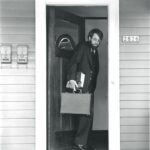Embarking on a historical voyage through men’s fashion unveils a captivating narrative of transformation, illustrating how societal dynamics, cultural influences, and technological progressions have left an indelible mark on men’s attire over the past century.
The Late 1800s: Paving the Way for Modern Elegance
The late 19th century marked a pivotal period of transition in men’s fashion, transitioning from the opulent attire of the Victorian era to the more streamlined and practical styles that would define the 20th century. Innovations like the introduction of the dinner jacket provided a comfortable alternative to formal evening wear, while the prevalence of the sack suit laid the foundation for the modern suit with its straight, unshaped lines.
The 1900s: Embracing Modernity
The dawn of the 20th century witnessed a departure from the rigid formality of previous decades, with menswear embracing greater comfort without sacrificing elegance. The Edwardian period popularized the three-piece suit as a wardrobe staple, characterized by narrow shoulders and a polished silhouette. Formal and casual wear became more distinct, signaling a shift towards versatility and practicality in men’s fashion.
The 1910s: Influence of War
The onset of World War I brought about significant changes in men’s fashion, as practicality took precedence over sartorial elegance. Military uniforms influenced civilian attire, leading to the adoption of trench coats and a subdued color palette. Despite the upheaval of war, the decade ended with a return to traditional menswear, setting the stage for the exuberant styles of the “Roaring Twenties.”

The 1920s: The Jazz Age and Liberation
The 1920s witnessed a seismic shift in men’s fashion, fueled by post-war optimism and cultural dynamism. The era embraced relaxed and expressive styles, departing from the formality of previous decades. The iconic flapper era introduced lighter fabrics, brighter colors, and sportswear into men’s wardrobes, reflecting a newfound sense of liberation and individuality.
The 1930s: Elegance Amidst Adversity
Despite the economic challenges of the Great Depression, the 1930s saw a resurgence of elegance in menswear. Hollywood’s Golden Age influenced fashion, with stars like Fred Astaire inspiring polished and sophisticated looks. The decade refined the balance between formality and functionality, laying the groundwork for timeless style that would endure for generations.
The 1940s: Wartime Restrictions and Utility
World War II brought austerity and utility to men’s fashion, with suits becoming more conservative and functional. The “Utility Suit” epitomized this period’s focus on practicality, while the post-war years witnessed a gradual return to luxury and excess. The 1940s also saw the emergence of casual wear as a distinct category, reflecting changing lifestyles and attitudes.
The 1950s: Return to Prosperity and Conformity
The 1950s marked a return to prosperity and conventional gender roles, reflected in tailored elegance and the emergence of the modern businessman’s wardrobe. The decade embraced both formal and casual elements, catering to diverse lifestyles and preferences. Hollywood continued to influence fashion, while youth culture rebelled against traditional norms, shaping iconic styles like jeans and leather jackets.
The 1960s: Decade of Revolution
The 1960s ushered in a period of radical change in men’s fashion, with styles that challenged conventional norms and embraced individual expression. Mod fashion and the hippie movement introduced bold and eclectic looks, while the peacock revolution celebrated color and flamboyance. Designers and boutiques led the charge for sartorial freedom, paving the way for diverse and experimental styles.
The 1970s: Era of Extravagance
The 1970s epitomized diversity and freedom in men’s fashion, with styles ranging from disco glam to rugged casualwear. The decade embraced flamboyant colors, bold patterns, and athletic-inspired clothing, reflecting a culture of self-expression and liberation. Ethnic and historical influences also played a significant role, adding depth and richness to men’s wardrobes.

The 1980s: Power Dressing and Casual Cool
The 1980s embraced excess and individuality, with power suits and designer labels symbolizing success and status. Casualwear took on a vibrant and eclectic aesthetic, influenced by sports and youth subcultures. Preppy styles offered a more refined alternative, while the New Romantics challenged gender norms and embraced creative rebellion through fashion.
The 1990s: Minimalism and Streetwear
The 1990s witnessed a shift towards minimalism and understated elegance, with grunge and hip-hop culture shaping mainstream fashion. Streetwear became increasingly popular, reflecting urban identity and youth culture. Business casual attire gained traction in the workplace, reflecting changing attitudes towards dress codes and professionalism.
The 2000s: Influence of the Digital Age
The 2000s saw the globalization of fashion and the rise of digital media, shaping trends and fostering a culture of fast fashion. Luxury brands and streetwear labels coexisted, catering to diverse consumer preferences. The decade emphasized comfort, practicality, and individuality, with a blend of old and new influences shaping men’s fashion.
The 2010s: Heritage Meets Modernity
The 2010s celebrated craftsmanship and quality, with a resurgence of tailoring and a focus on classic menswear elements. Techwear and streetwear continued to influence mainstream fashion, blurring the lines between luxury and casual wear. Social media transformed how trends were disseminated, while sustainability emerged as a key concern in fashion.
Conclusion
In conclusion, the evolution of men’s fashion over the past century reflects a dynamic interplay of tradition and innovation, culture and commerce. Each decade has contributed its unique perspective to the ever-changing landscape of menswear, showcasing the enduring power of style to reflect and shape the world around us.












